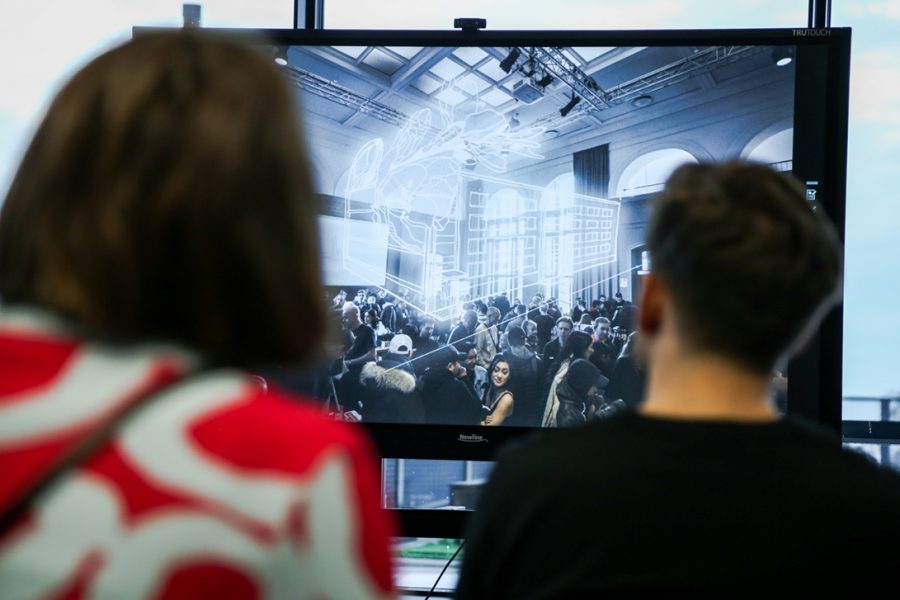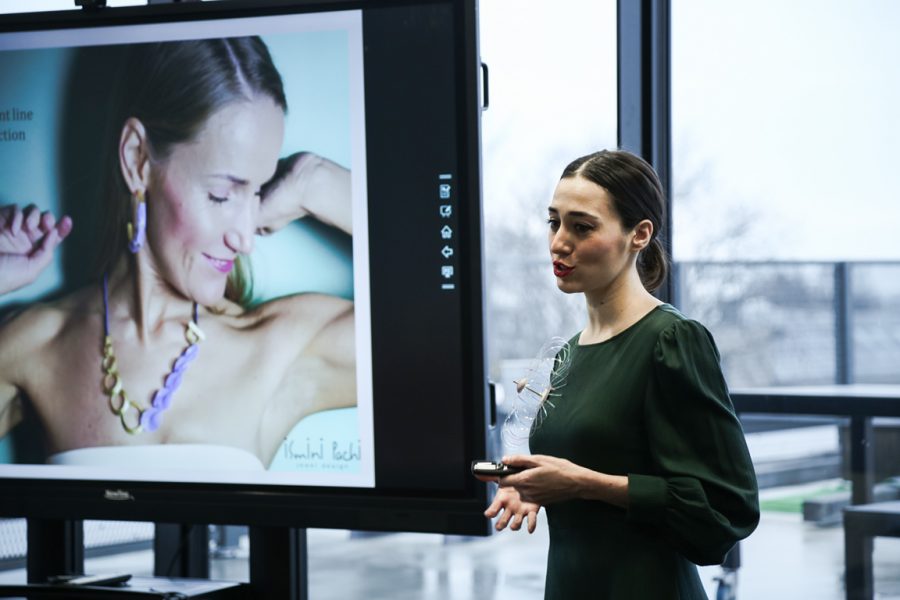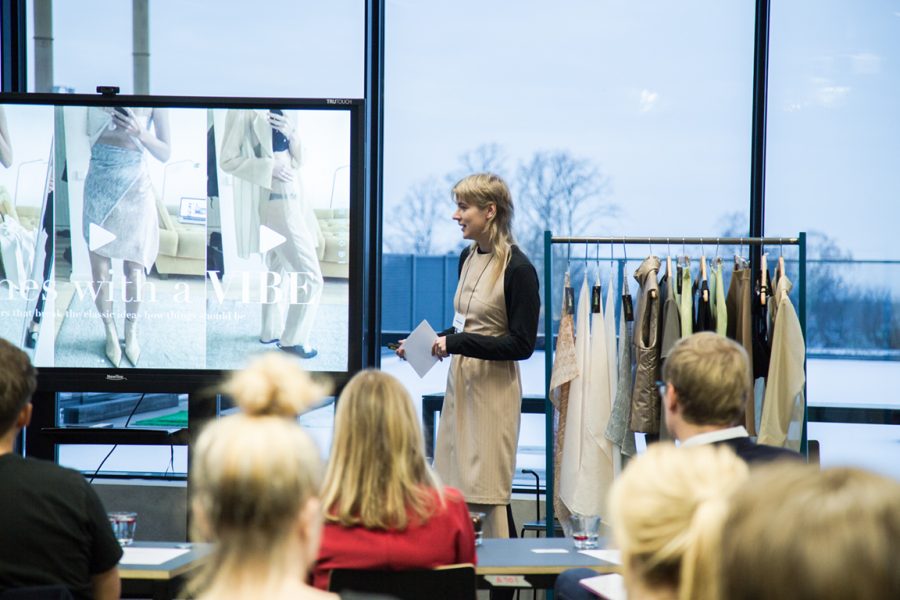Last Autumn Estonian Academy of Arts (EKA for short) decided to offer a coaching program for the last year master degree design students in order to give a helping hand in business development for international markets. Business, fashion and design industry’s respected consultant and coach Sissi Silván shared her experiences and, first and foremost, her great business contacts as guest speakers with Estonian students.
With no surprise, Sissi’s resume speaks for itself. She launched a world-known brand H&M in 1997 in Finland, owns a consultancy firm that operates in Finland and Scandinavia, invests via Finnish Business Angels Network, has several board positions and has managed countless other companies around the world. No doubt she has proved herself as a strong mentor in business development.
We met with Sissi right before Christmas after she had finished her programat Estonian Academy of Arts, where the students just had the opportunity to showcase their work to influential Scandinavian entrepreneurs and investors. Estonian talents were recognized by Betina Simonsen, CEO of Lifestyle & Design Cluster in Denmark; one of the most successful Finnish design brands ByPias CEO and creator, Pia Erlund; Maria Lipasti, the owner of Helsinki’s leading design store La Matta; Riivo Anton from Estonian United Angels VC; Ira Stening from Finnish Business Angels Network; and Pontus Juntunen from a private investment company AnCann Group. Sissi brought a new perspective to the house of EKA and proved that designers can benefit from business coaching and the curriculum should also include business skills for their future business to bloom.
In light of this new coaching program at Estonian Academy of Arts’s curriculum, we talked with Sissi Silván about her former experiences, observations and curious discoveries about Estonian design market and designers. Meet Sissi Silván, the energetic business mentor and coach at EKA.

Let’s start from the beginning. You have an impressive resume in creating brands and in the retail business. Could you please introduce yourself with your own words – who is Sissi Silván and what has been your journey in the design industry?
I would like to see myself as a blonde Pippi Longstocking in the sense that I only mean good, but am also very direct and only do things that I believe in. Coaching at Estonian Academy of Arts is one of those things I believe in.
I have not worked all the time in design or retail, I have been doing many different things. I have taken a lot of my own initiative finding new interesting projects. I have been an Operative Director, running an international marketing and design agency, the first Country Director for H&M in Finland, and worked as a Board Professional for many additional design-related companies. I have also worked as a consultant for the last ten years, helping Finnish design companies to grow internationally. I have been doing that as an independent consultant, and as Head of Scandinavia at Business Finland, based in Copenhagen. In addition, I am working as a coach mentoring young designers and running similar type of coaching programs like I did in EKA last Autumn.
As you mentioned, you have coached a lot of Finnish design companies. What kind of similarities and differences do you see between Estonian and Finnish design scenery?
The similarities are the challenges in growing. I was working at EKA with last year’s master degree students who are out in the world after the spring season. Many of the students have had their own brand for several years already. The starting point for them is the same both in Estonia and in Finland – they haven’t had business coaching before, as no business studies are automatically included in their curriculum.
So, what is important in the design business? It’s the branding. Nobody really needs your product unless it is food or pharmaceuticals. The good news is that there are millions of people who want to be inspired by wonderful design, beautiful everyday clothes, beautiful objects at their home. But these people need to get inspired. They need to get the desire for your products. So this is the challenge – creating a brand image, a true story behind, something that speaks out on Instagram, Facebook, in webshops. The good thing for Estonian designers is that your design is continental with an interesting Slavic-Estonian flavour. There is something special in it, and it is often also commercial. So it’s quite easy to fall in love with it.
You mentioned desire, it’s so fundamental for a company to create a desirable brand. But how do you do that in the design industry, what are the key factors for it?
In a way, there’s a lot of different aspects. As a whole, the brand has to have an interesting story behind, and a meaning and mission to do something good. What is the mission, what is the benefit that you are going to create for the world? Also the look of the brand, the visual brand. Not only the product but the look of everything. In order to succeed, you need to decide and understand from the very beginning who is your key target group. That is the place where to start because there should offer joy or solve a problem for that specific target group. Of course everybody is welcome to buy your products, but if you are designing something for everybody, then I’m sorry – there might be no interest for anybody.
You and your team launched H&M in 1997 in Finland, I am certain that you have extraordinary knowledge from this experience to share with us. What were the main challenges in launching such a big brand, what were the successes?
H&M was an European brand at that time, and was operational only in 11 countries whereas today they are functional in over 70 markets. Me and my organization, we wanted to take on the challenge of making H&M into a much higher profile brand in Finland than what it was seen before. And honestly, thanks to the wonderful committed staff with extremely high motivation we really achieved that. So if you ask me what has been my biggest success within the design-related industry, I would say that it is that we managed to establish H&M in a totally different image level from what it had been before, and consequently to reach out to new target groups and great financial results.
The biggest challenge was in communication because H&M was accused of using child labour and of course, a smart brand should never ever do that, and would try to avoid any unethical situations. So my challenge was not to communicate that we never make mistakes, but to get across with the message that we really try to do everything possible to avoid any unethical work. In the end, there were all the colours and feelings in working for H&M – everything from challenges into wonderful successes.

I agree, communication is really important to any brand, as is the business side of it. Please tell our readers why should design education also provide knowledge on how to build a brand and how to communicate, as a part of effective business development?
It is so self-evident once you say it out loud – most design students who graduate become entrepreneurs. In Estonia the students very seldom have an opportunity to be employed by a design company. On the other hand, going to work abroad I would recommend even more. You grow so much and get so much wider view and perspective of the world.
As many design students are going to be entrepreneurs it is very important to have lots of realistic self-confidence. Knowing what your strengths and weaknesses are. Realising what are the resources you need to have around you? The network, the contacts, the people. This is something we also did in EKA’s program. I made it clear from the beginning that the students will not get any straight answers, but they will get the support and self-confidence to make your own decisions. You have to shine for your brand, you have to make people interested in you.
How and why did you choose to coach in Estonia, specifically at the Estonian Academy of arts?
It’s a wonderful and not so long story. We have big respect for Estonians in Finland, and at home, I still get the paper version of the Sunday’s newspaper to my home. Around May I was reading the paper and I turned the page because there was something about Estonia and design. And it was a long one-page article about EKA and its great new premises. But they also had something about the education of design that touched me, because it had some of the same principles as in Denmark. In Denmark education is often separated into three parts – visual education, practical skills and commercial and business skills. I went to the internet to see if EKA also has the business part in its curriculum, but I couldn’t find it and I looked out who the dean of the design faculty is. Hence I wrote to Kristjan Mändmaa to congratulate him on the article and asked if they have any business skills in the curriculum – and if they don’t, I can just come over and say hello and see if something happens. I met with him and Piret Puppart, the Head of Fashion Department and I really admire that EKA immediately realised the need for this program and managed to put it together saying: “Just do it!”
As you worked with the students for a whole Autumn term, please tell our readers what are the most interesting things that you learned about Estonian designers during your coaching program?
We limited the number of participating students to 15, so not everybody from the second year was participating. The ones that were accepted to the program, were highly motivated and they have a hunger for business skills. They think it is beautiful being commercial. The students were so open and any feedback they got, they had the self-confidence of really listening, thinking and sometimes suggesting something else.
Estonian design that I have seen is beautiful and adorable. There is a lot of potential, but the branding needs to be better. They should be taking their own initiative and realising that also selling is beautiful. Without sales and goal-oriented marketing, there is no market for any brand.
What is your advice for Estonian designers to become successful?
Create the brand and the overall business concept first. What is it that your brand is all about, and what do you want to reach? When there is a will, there is a way.
In the beginning, one´s design is often concentrated on certain parts or wonderful details of showpieces. That’s great, but I think almost every designer should realize that these will be the pieces for the media’s attention only. However, you can seldom make good money on those pieces. They might have a high price tag, but it is also a high cost to make them. Commercial thinking should include the question of what will be your cash cows? The great showpieces will create the image, but people also need those less expensive pieces that they could buy and wear. That is one important part of being business-wise.
I would also strongly recommend being open for investors – they can bring in the money needed for international expansion, but also a lot of business experience and contacts that you as a designer seldom can have. Another option to consider is to engage from the very beginning a team with additional skills like sales and marketing, and sharing the business with them.
Together we are strong, and it can be much more fun to own a slice of a 100 million business than owning 100 per cent of a 100,000 euro business.
Additional information about the program and its participants is available on EKA’s homepage.
All the photos are taken from the showcase of the students works to influential Scandinavian entrepreneurs and investors.
Photos: Sandra Luks






